Spot List
Meifeng Lake
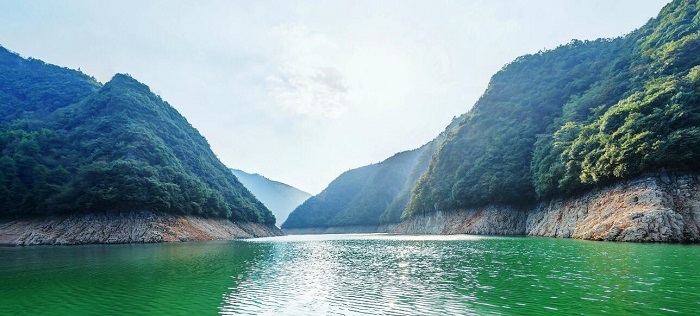
Meifeng Lake is the only artificially constructed scenic area within the Meijiang Scenic Area and one of the two picturesque lakes in Meijiang. Construction commenced in 1974 and was completed in 1992. With the Xiangbi Cliff and Zhuyun Peak on either bank serving as natural barriers, the lake spans over 20 kilometers, with a water storage capacity of 45 million cubic meters. The Dajiangkou Reservoir features a double-curvature arch dam, with a crest length of 244 meters and a height of 82 meters, having once won the National Best Design Award. Within the scenic area, there are 255 terraced fields known as the "Fields of the Gods," resembling a disc shape spreading outward, with the largest mound covering 39 square meters and reaching a height of 1.1 meters. It is one of the ten most spectacular sights in Meijiang. The distribution of scenic spots is dazzling. Dajiangkou is a typical waterland with idyllic rural scenery.
Natural Bridge

The Natural Bridge, also known as the Fairy Bridge, is located within the Maokou Formation limestone on the eastern limb of the Chetianjiang Syncline in the Lian-Shao Basin. Formed over thousands of years by the erosive action of groundwater and gravitational collapse, it is the only double-curvature, triple-arch natural bridge discovered in China's carbonate rock karst development regions. Its shape is extremely unique, and its momentum is very majestic. To the south of the bridge lies a single-arch bridge, 40 meters high and spanning 10 meters, known as the "Inner Fairy Bridge." Crossing a small stream and slightly to the north, a double-arch bridge can be seen, 50 meters high and spanning 30 meters, known as the "Outer Fairy Bridge." Connected as one, the inner and outer fairy bridges form a complete and naturally charming triple-arch overpass. Below the bridge, a small stream flows, and four small stone peaks beside the bridge resemble four bridge piers. Visitors here can see white clouds drifting lazily above the bridge, streams flowing like music below, lush forests at the bridgehead, and birds chirping in the woods, resembling a fairyland on earth. To the south of the bridge lies the Xianrenfu Karst Cave. Here, towering peaks rise with lush greenery, and steep cliffs stand tall. Several stalactites hang from the cave entrance, each with a unique shape. Entering, one finds a large hall 60 meters high and over 100 meters long, known as the "Gathering of Fairies Hall," capable of accommodating thousands of people for rest. Inside the cave, a cool breeze blows, and a small stream, actually an underground river, flows from the center outward, forming a 30-meter-high waterfall that cascades down onto a massive rock resembling a beautiful turtle, splashing countless pearls. The patterns formed by the stalactites on the ceiling of the hall are magnificent, resembling the "Flying Apsaras" in Dunhuang murals, with graceful postures and a desire to float down. Inside the cave, there are also two branch caves on the left and right. The right cave is over 30 meters deep, while the left cave is over 2,000 meters deep, winding and zigzagging, with glittering gold and silver, truly a marvel of creation. Thus, it is known that before the Natural Bridge was formed, the underground river's flow path, including the Xianren Cave and the stream bed below the bridge, was shaped by the long-term erosion of groundwater flowing through underground pipes, continuously widening and heightening the pipes to form karst caves. The near-horizontal rock layers on the top of the karst caves and the fissures in the vertical pipes led to the collapse of the top rock blocks under gravity, which were then carried away by flowing water. Over thousands of years, as the karst caves formed by the underground river pipes near the surface collapsed entirely in fissured areas, with rock blocks carried away by flowing water, while in less fissured areas, rock blocks remained on the top and sides of the pipes, gradually forming the present double-curvature triple-arch bridge. This bridge is a typical example of carbonate rock karst landscape in China.
Geological Museum
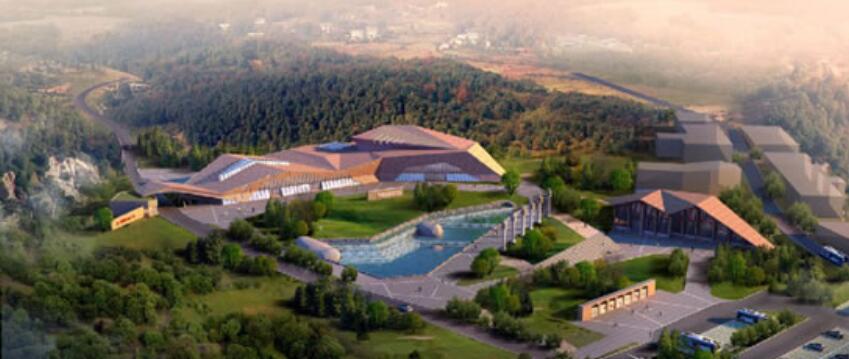
The Meijiang Geological Museum is situated within the core scenic area of the Loudi Meijiang Scenic Area. Covering a building area of 2,993.49 square meters, its design is inspired by the continuous mountain ranges of Meijiang, featuring an "M"-shaped exterior structure. It is divided into several areas, including the Preface Hall, Earth's Mysteries Hall, Geological Landscape Hall, Karst Landscape Hall, Human Geography Hall, Resource and Environment Hall, and 3D Lecture Hall. Utilizing graphic display panels, physical specimens, and multimedia equipment such as "sound, light, and electricity," it fully showcases the geological features, geological heritage landscapes, and local customs and cultural heritage of Meijiang to visitors.
The Meijiang Geological Museum displays the geological wonders formed throughout Meijiang over years of geological movements, with geological heritage sites scattered throughout every corner of Loudi Meijiang. These heritage sites are extremely rare. Inside the Meijiang Geological Museum, introductions and model displays of these heritage sites allow visitors to better understand these rare attractions. There are also detailed explanations of the traces and paths of geological movements in the history of Loudi Meijiang. The detailed explanations make Meijiang even more fascinating to visitors who want to learn about its geological structure.
The Meijiang Geological Museum also features a large number of service facilities specifically prepared for visitors. The rest area has a large capacity, which is the biggest highlight inside the Meijiang Geological Museum. In front of the museum lies a large square where visitors to the Meijiang Scenic Area can gather. Adjacent to it is a parking lot, adding to the convenience. The layout and design of the entire Meijiang Scenic Area radiate from the Meijiang Geological Museum to surrounding attractions and landscapes. After learning about the geological landscapes in the Geological Museum, visitors can then delve deeper into the Meijiang Scenic Area to appreciate and explore these landscapes. This user-friendly design was also planned when the Geological Museum was constructed.
The Meijiang Geological Museum has a unique exterior shape, distinctly different from the surrounding residential styles. The museum in the Meijiang Scenic Area is divided into two parts, connected by a corridor. With physical displays, model displays, and detailed explanations, as long as one observes and reads with care, it is not difficult to gain a general understanding of the geology of the Loudi Meijiang Scenic Area. The local culture of Meijiang is also displayed in the museum, with "Meishan Culture" being a historically renowned "non-subordinate to the king" culture.
Dajiangkou
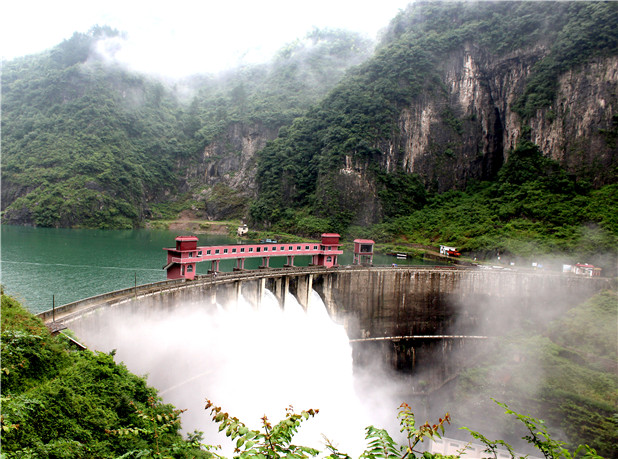
The Dajiangkou Scenic Area is located in the northwest of the Meijiang Scenic Area and is a medium-sized artificial reservoir with a water storage capacity of 60 million cubic meters. It is a water-based tour area centered around Meifeng Lake. The main attractions include Meifeng Lake, Lanyue Ancient Path, Meijiang Dam, Fields of the Gods, Twelve Turns, A Pillar of Incense, Qingliu Pool, Golden Turtle Playing in the Water, Zhuyun Peak, Lake Center Island, Monkey Family Ancient Tree Group, Zhuyun Thatched Cottage, and the Hometown of General Wu Dusi. Meifeng Lake is nestled among the mountains and valleys in the upper reaches of Meijiang, with Zhuyun Peak and Chuanyun Peak facing each other across the river, towering cliffs rising high, squeezing Meijiang into a narrow river mouth where water and mountains merge, mountains part for water, and water follows mountains, creating a breathtaking landscape of mountains and waters. Boating on the lake, with gentle waves rippling, a thin mist like silk hovering over the water, occasional waterbirds frolicking and fish leaping, the scenery of lakes and mountains is truly breathtaking.
Ten-Mile Gallery
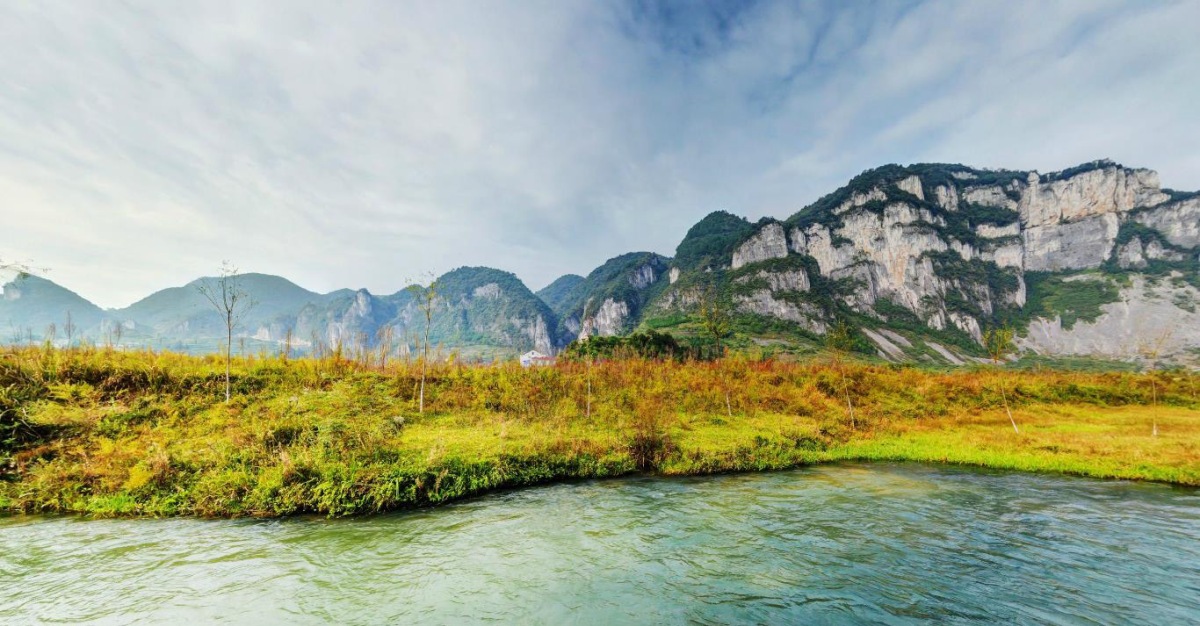
The Ten-Mile Gallery in the Meijiang Scenic Area is located in Huangluowan, also known as the Huangluowan Cliff, renowned as "One of the Three Gorges in Hunan." The cliff stands tall and majestic, with a magnificent aura, stretching 3,500 meters along the west bank of Meijiang and reaching a relative height difference of 360 meters with the riverbed. The cliff face is nearly vertical, resembling a massive Great Wall barrier. On the cliff face, colorful and diverse strange patterns are formed by weathering, with colors changing with the seasons and the passage of dawn and dusk, creating a colorful Ten-Mile Gallery that can be considered a unique marvel in China. According to karst geological experts, such a large-scale cliff face in a karst landscape area is extremely rare and is a national-level geological heritage site.
Saihai Lake
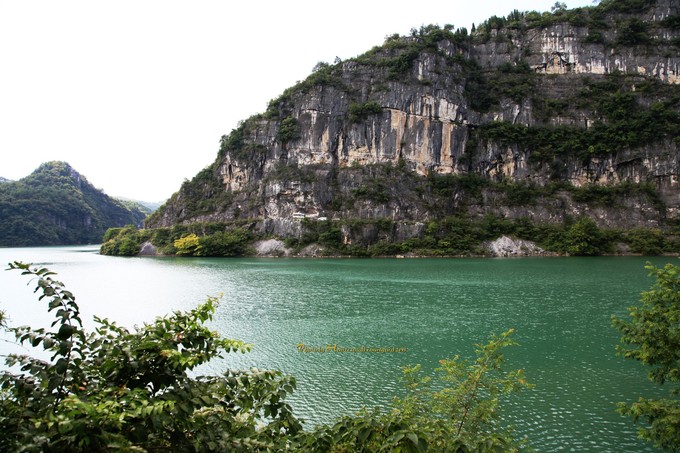
Saihai Lake is a natural karst lake, also known as Meitang Lake, formerly ranked first among the "Eight Scenic Spots of Anhua." Covering a water area of 0.25 square kilometers with a water storage capacity of 8 million cubic meters, the lake surface is at an elevation of 329.7 meters and runs northwest. This lake was originally an underground river in a karst cave formed by the dissolution of tectonic fissures running northwest. Later, due to crustal uplift, it emerged to the surface and gradually developed into a lake after weathering, erosion, and dissolution caused the cave roof to collapse.
The lake surface is green and clear throughout the year, unpolluted; boating on the lake, with gentle waves, towering cliffs emerging on both sides, their reflections dancing in the water, the scenery moving with the mountains; lush forests and vibrant wildflowers competing for glory in the mountains, with birds chirping merrily. It is like a poem, a painting, a fairyland, and a dream.
Saihai Lake is the main water-based tourism landscape in the Lianyuan Meijiang Scenic Area and is the central scenic area of Meijiang, formed by the convergence of Meijiang's waters. The main attractions of Saihai Lake include the picturesque Saihai Lake itself, directly connected to the Meijiang waters. Surrounding Saihai Lake is the "Ten-Mile Gallery" of the Lianyuan Meijiang Scenic Area. Numerous peculiar peaks and cliff faces also stand tall around Meijiang's Saihai Lake. When touring Saihai Lake, one can take in all these magical landscapes at a glance. Visitors jokingly say that boating on Saihai Lake is like touring a painting.
Saihai Lake boasts many stunning landscapes, such as the Hezhang Cliff and Echo Wall. The "Ten-Mile Gallery" of Meijiang has engraved many ancient poetic masterpieces, which visitors refer to as the "Poetic Rock of Meijiang." Poetry and literature enthusiasts can boat on Saihai Lake in the Poetic Rock of Meijiang and slowly savor these poetic masterpieces on the cliff faces. Below the cliff faces, looking up, the Poetic Rock of Meijiang stands vertically and steeply, majestic and awe-inspiring, leaving visitors in admiration.
Near Saihai Lake, there are also landscapes such as Tianzi Mountain, Guanyin Watching the Sea, and Helmsman Peak. These landscapes are all peculiar peaks and rocks that resemble various shapes. Appreciating the wonders of the Lianyuan Meijiang Scenic Area with imagination can bring even more joy. Walking to appreciate the beauty of the Meijiang Scenic Area is, of course, delightful. Boating to appreciate the beauty is even more comfortable and pleasant, with the cool breeze of Meijiang's Saihai Lake gently blowing and the fragrance of water plants filling the air. Land tours and water tours offer two distinct experiences. A land tour actually follows the walking path along the edge of Meijiang's Saihai Lake.
The water color of Saihai Lake changes with the seasons. Different light colors reflect on Saihai Lake, creating varying hues in the eyes of visitors. The Lianyuan Meijiang Scenic Area is never lacking in vibrancy and change. These colorful world wonders have earned Meijiang a reputation for mysterious charm in the eyes of visitors. In misty weather, the misty ambiance of the Lianyuan Meijiang Scenic Area fills Saihai Lake with an ethereal quality, with white mist hovering over the lake. Boating in it, one instantly feels carefree and leisurely, realizing that the joy of immortals is in Meijiang.
The water plants and peculiar peaks submerged in Saihai Lake, along with the countless fishing activities, create a picturesque scene for the entire Lianyuan Meijiang Scenic Area. The moisture and exquisite beauty, the tranquility and harmony here, all add to the beauty of Saihai Lake in the Lianyuan Meijiang Scenic Area. To truly experience the life of Meijiang, one must take a boat ride on Saihai Lake in the Lianyuan Meijiang Scenic Area. Otherwise, one cannot truly claim to have experienced Meijiang.
Xianrenfu (Fairy Mansion)
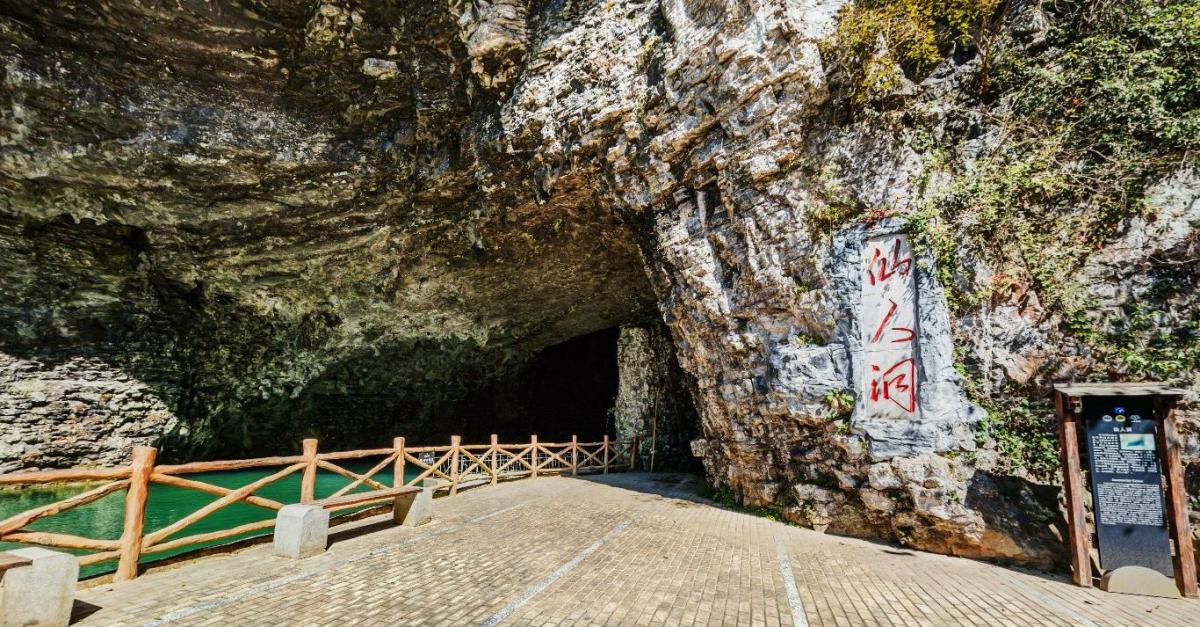
Xianrenfu is a large natural bridge formed by vertical joint fissures under the erosive action of groundwater and gravitational collapse. It is a geological heritage landscape group composed of steep cliffs, natural bridges, karst cave groups, canyons, waterfalls, and streams. The main attractions include the Fairy Bridge, Fairy Cave, Longevity Waterfall, Fairy Footprints, and the Oriental Venus.
The Fairy Cave is 280 meters long, 30 meters wide, and 60 meters high, characterized by caves within caves, skies visible within caves, flying bridges above skies, streams below bridges, waterfalls formed by flowing water, and turtle stones struck by cascading waterfalls, creating a fascinating and captivating scene. Especially noteworthy are the two natural bridges soaring in the air, 50 meters high and spanning 30 meters, which are rare self-formed stone arch bridges in the world. The double-arch natural bridge resembles the initial letter "M" of the pinyin for "Mei," while the single-arch natural bridge resembles the initial letter "J" of the pinyin for "Jiang," combining to form "MJ" ¨C Meijiang, a scenic spot with a typical domain name logo in China. Below the bridge lies the nearly 30-meter-high Longevity Waterfall, cascading down, while a massive "Spirit Turtle Stone" weighing over ten tons remains steadfast despite the washing of the waterfall. Nature here forms a multi-layered mysterious space, allowing visitors to experience the joy of wading in water, the fascination of exploring caves, the fun of playing with waterfalls, the thrill of climbing cliffs, the wonder of observing bridges, and the wilderness of stepping into secluded areas. It can be described as fascinating and infinitely enjoyable.
Xianglu Mountain
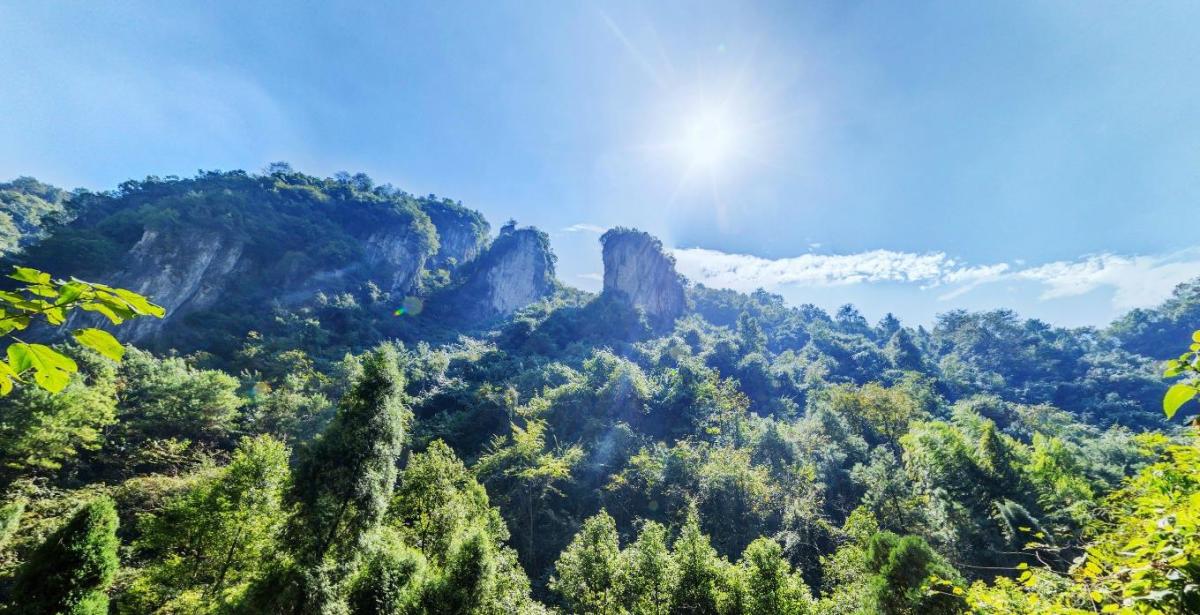
The Xianglu Mountain Scenic Area features an aged peak forest landscape, with peaks generally ranging from 30 to 150 meters in vertical height. The main peak, Xianglu Peak, stands at an elevation of 587 meters with a relative height of nearly 100 meters, resembling an incense burner. It is formed by the erosion of surface water, the dissolution of groundwater, and physical weathering along joint fissures, creating unique geological landscapes such as dolines, depressions, stone cones, stone peaks, and narrow gorges. The stone peaks vary in shape, resembling people, objects, birds, and beasts, vividly lifelike. The main attractions include Xianglu Peak, One Stone Eight Views, Desheng Gate, Ancient Battlefield, Ancient Cannon Fort, Heavenly Bullet Ready to Launch, Ambush Trench, Stone Flag, Hua Tablet, Lion Guarding the Fort, and Meridian Gate. Especially noteworthy is the "One Stone Eight Views" rock pillar, standing precariously on a wide plain, over 20 meters high, presenting eight different landscapes from eight different angles: "Loving Mother Carrying Her Child, Strict Mother Teaching Her Child, Husband and Wife Seeing Off Their Child, Parents Visiting Their Child, Longing Mother and Child, Two Elders Anticipating Their Child, Returning Home Prodigal, Pilgrimage Mother and Child." These landscapes are vividly lifelike, allowing visitors to appreciate the emotions of "maternal love as vast as the sea, paternal love as firm as a mountain," evoking feelings of reverence and admiration, truly remarkable.
Guanyin Cliff
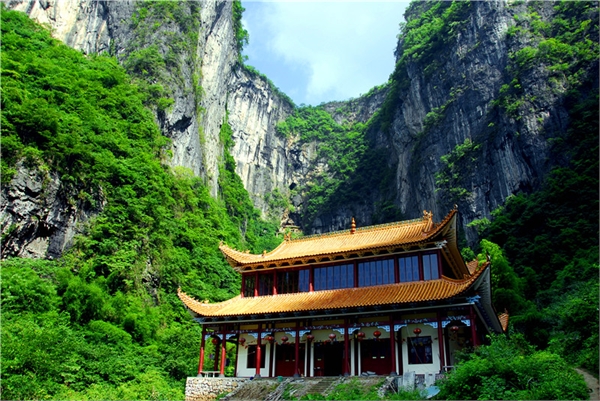
The Guanyin Cliff in Meijiang stands at an elevation of 499.8 meters with a relative height difference of 300 meters. It is a semi-circular cliff embracing a ring-shaped alley formed by karst erosion, with a ring diameter of about 500 meters. Originally a sinkhole, the cliff was formed by continuous collapses due to crustal uplift. Currently, five cliff-side caves are still developing on the cliff face: Guanyin Cave, Hidden Buddha Cave, Arhat Cave, Panjiao Cave, and Sutra Hiding Cave. During the rainy season, water cascades down the cliff face, forming a massive waterfall hundreds of meters high, creating a truly spectacular scene.
Cangjun Cave
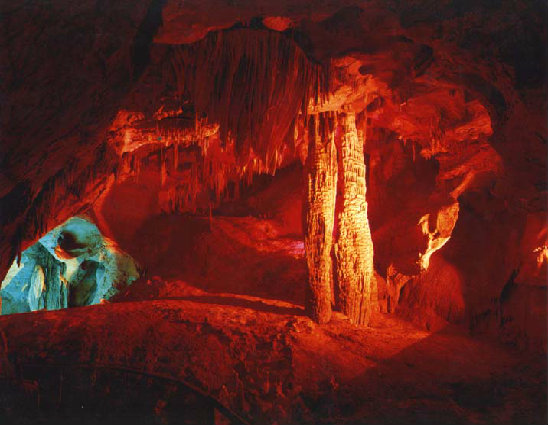
The Cangjun Cave in the Meijiang Scenic Area is a semi-circular cliff surrounded by karst formations, with a diameter of 0.5 kilometers. The Guanyin Cliff stands at an elevation of 499.8 meters with a relative height of over 300 meters. It is a circular alley-style cliff formed by karst erosion. Originally a sinkhole, the cliff was formed by continuous collapses due to crustal uplift. Currently, five cliff-side caves are still developing on the cliff face: Guanyin Cave, Hidden Buddha Cave, Arhat Cave, Panjiao Cave, and Sutra Hiding Cave. Together with Cangjun Cave, they are distributed at three heights: 500-350 meters, 350-250 meters, and 250-150 meters. The multi-layered distribution of caves on the cliff reflects three intermittent crustal movements, holding significant geological importance.
According to research, Cangjun Cave is over 25,000 meters deep, with approximately 4,000 meters currently explored. Its features include caves within caves and rivers within caves, with winding and zigzagging paths. Entering the cave, one must marvel at the incredible craftsmanship of nature. An underground river flows within the cave, never drying up throughout the year. Meijiang's Cangjun Cave is distributed within the Carboniferous and Upper Carboniferous carbonate rocks. The cave is rich in stalactites hanging from the ceiling, including stone bamboo shoot, stone pillars, stone curtains, stone towers, stone statues, and more. Cangjun Cave is a large carbonate rock karst cave with charming landscapes and unique structures. It is composed of twelve karst cave groups, numbered from the outside in: Protecting the King Hall, Emperor Huidi's Palace, Double Heaven, Southern Inspection Hall, City of Eternal Night, Dragon and Phoenix Palace, Northern Hall, Southern Hall, River Dam, Parade Ground, National Treasure Hall, and other karst landscape areas. These twelve karst cave groups are distributed along the underground river in a "candy gourd string" pattern.
Three Rock Gates
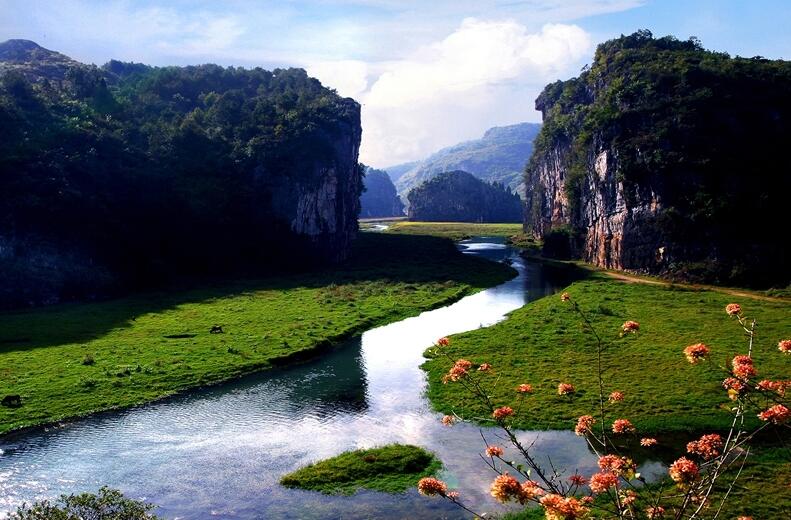
The Three Rock Gates are located on Saihai Lake in the Lianyuan Meijiang Scenic Area. The Three Rock Gates are three layers of rock gates, uniquely formed by peaks in the Lianyuan Meijiang Scenic Area, with wide cracks between the peaks that resemble two open doors. The Three Rock Gates in the Lianyuan Meijiang Scenic Area consist of three layers, standing tier upon tier. Visitors praise: "Savoring Meijiang for a moment leaves one intoxicated for three days." Currently, the Three Rock Gates are the iconic landscape of the Lianyuan Meijiang Scenic Area, serving as a symbol representing the beauty of the Lianyuan Meijiang Scenic Area in any external promotions.
The first layer of the Three Rock Gates is called Hexin Cliff, also known as Hezhang Cliff by locals. It resembles two separated palms facing each other across the river. This wonder can currently only be found at Saihai Lake in the Lianyuan Meijiang Scenic Area and nowhere else. The first layer of the rock gate is also known as the "Eastern Heavenly Gate." Looking inward from the first rock gate, one can see the second rock gate of the Lianyuan Meijiang Scenic Area, the "Middle Heavenly Gate." The "Middle Heavenly Gate" of the Lianyuan Meijiang Scenic Area is higher on the left and lower on the right, resembling a gate about to open. Meijiang turns at the second rock gate in the Lianyuan Meijiang Scenic Area, after which the water surface gradually widens, and the flow becomes slower.
Passing through the second rock gate of the Lianyuan Meijiang Scenic Area and looking back, one can see an eagle with its wings spread, ready to take flight. This is the "Eagle's Beak Cliff" of the Lianyuan Meijiang Scenic Area. Soon, one arrives at the third rock gate of the Lianyuan Meijiang Scenic Area, known as the "Western Heavenly Gate," which is relatively far from the first two rock gates. The third rock gate is also the eastern gate of the Ten-Mile Cliff in Huangluowan, standing over 80 meters high and over 20 meters wide, with a shape somewhat similar to the Eastern Heavenly Gate.
The Three Rock Gates of the Lianyuan Meijiang Scenic Area can be seen in various promotional brochures and are the iconic pattern of Meijiang. Regardless of the water level in Meijiang, the beauty of the Three Rock Gates remains constant. The flowing water and water plants below the Three Rock Gates are also important embellishments. The Three Rock Gates of the Lianyuan Meijiang Scenic Area are adorned with red flowers and green waters, modified by flowing water and fishermen, evoking a pastoral and paradise-like atmosphere. The Three Rock Gates of the Lianyuan Meijiang Scenic Area have left a deep impression on visitors. When visiting the Lianyuan Meijiang Scenic Area, one must not miss the Three Rock Gates of Meijiang.
Longevity Waterfall

The Longevity Waterfall is located at the end of the Fairy Cave in the Xianrenfu Scenic Area of Meijiang. Taking a boat from the cave entrance inward, passing through the massive Gathering of Fairies Hall, one arrives at the end of the Fairy Cave and sees a nearly 30-meter-high natural waterfall cascading down, known as the Longevity Waterfall, with water striking the Linggui Stone below. The county chronicle from the Qing Dynasty also referred to this place as the Linggui Cave.
Lotus Spring
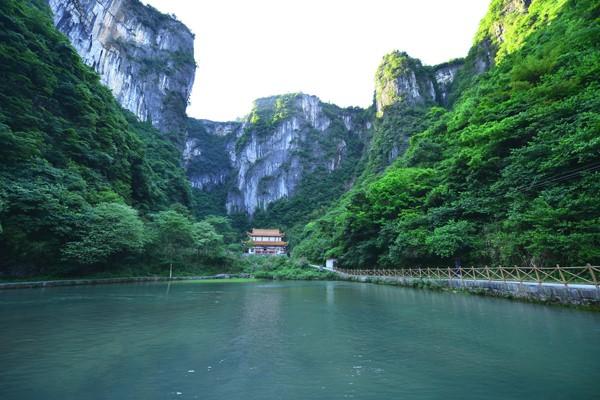
The Lotus Spring in the Meijiang Scenic Area is located within the Guanyin Cliff-Cangjun Cave Scenic Area and is a large-flow ascending spring. The spring's flow rate reaches a maximum of 5,000 L/S and a minimum of 500 L/S, flowing continuously throughout the year. The spring water emerges from five surrounding spring eyes, each with a dynamic water diameter of 1-2 meters. This spring is distributed within a lotus pool, resembling lotus flowers from afar, gently swaying in the pool, and appearing as boiling and rolling water up close. It is one of the few peculiar ascending springs discovered in China.

